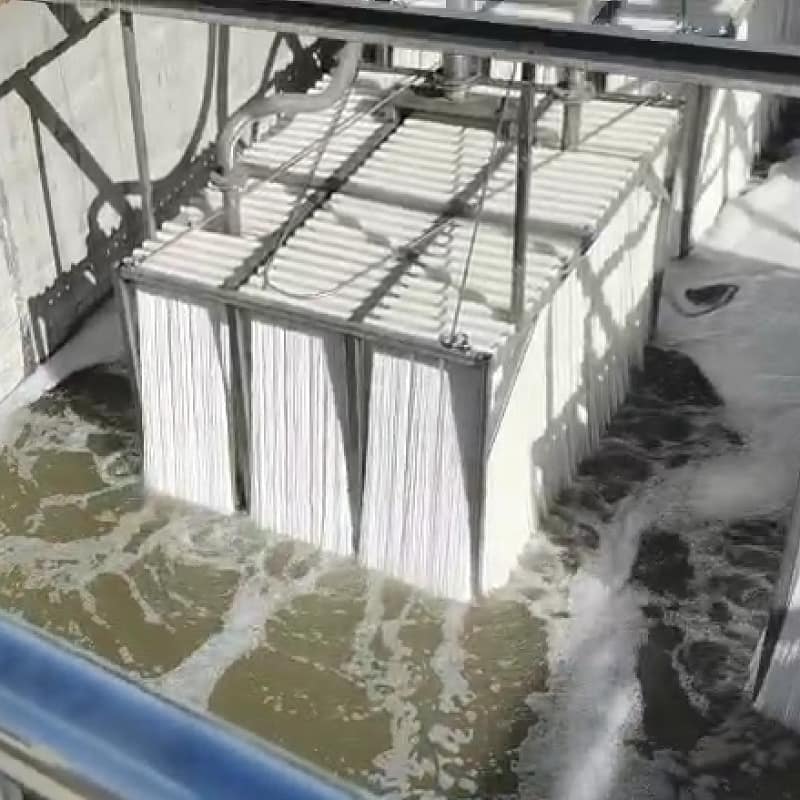Key Causes and Solutions for Blackened Activated Sludge
Focus Keyword: black sludge in wastewater treatment
Blackened activated sludge is a typical abnormal phenomenon in wastewater treatment operations. Its root cause lies in oxygen deficiency or anaerobic conditions, which lead to abnormal microbial metabolism and chemical reduction reactions. This article explores the key causes and countermeasures of black sludge in wastewater treatment systems.
1. Core Cause: Anaerobic/Anoxic Reduction Reactions
1.1 Sulfide Formation and Transformation
- Activity of Sulfate-Reducing Bacteria (SRB): Under DO < 0.5mg/L, SRBs reduce sulfate (SO₄²⁻) into hydrogen sulfide (H₂S):
SO₄²⁻ + Organic Carbon → H₂S + CO₂ + H₂O
- H₂S Reacts with Metal Ions: H₂S combines with Fe²⁺ or Mn²⁺ to form black precipitates:
H₂S + Fe²⁺ → FeS↓ (black) + 2H⁺
H₂S + Mn²⁺ → MnS↓ (black) + 2H⁺
1.2 Sludge Putrefaction
In secondary settling tanks or dead zones, stagnant sludge can undergo anaerobic fermentation, producing H₂S, CH₄, and organic acids. This results in black, odorous, and floating sludge.
2. Direct Inducements
2.1 Aeration System Failures (Most Common)
- Blocked Diffusers: Uneven aeration, large bubbles, or no bubbles → Local DO near 0
- Low Blower Pressure: System-wide DO < 1mg/L → Global oxygen deficit
- Damaged Aeration Pipes: Decreased aeration efficiency → Insufficient oxygen delivery
- Insufficient Aeration Time: In SBR processes → Incomplete nitrification and degradation
2.2 Influent Water Quality Shocks
- High COD Load: From piggery wastewater or feed leaks → Microbial oxygen demand exceeds supply
- High Sulfate Concentration: e.g., Copper sulfate disinfectants → More substrate for SRBs
- Direct Sulfur Input: Slaughterhouse wastewater or pesticide residues → Direct introduction of sulfides
2.3 Operational Management Issues
- Excessive Sludge Concentration: MLSS > 6000 mg/L → Poor oxygen transfer, local anoxia
- Poor Sludge Return: Pump failure or scraper malfunction → Anaerobic sludge decay in secondary clarifier
- Toxic Inhibition: Disinfectants or antibiotics → Microbial activity drops
3. Onsite Diagnosis Techniques
3.1 Sensory Observation
- Odor: Rotten egg smell indicates H₂S presence
- Color: Uniform black → System-wide oxygen loss; Localized → Uneven aeration
- Foam: Sticky black foam indicates sludge putrefaction
3.2 Instrument Monitoring
- DO Meter: Target 2–4mg/L
- SV₃₀: Normal: 15–30%, brownish; Abnormal: >40%, blackish and slow settling
- ORP: Normal: +50 to +250mV; Black sludge: <-100mV → Strongly reducing
3.3 Microscopic Examination
- Sulfide Particles: Shiny black particles inside flocs (FeS/MnS)
- Microbial Changes: Disappearance of ciliates/rotifers; Increase in filamentous bacteria
4. Solutions and Controls
4.1 Emergency Actions
- Boost Aeration: Increase DO to 4–6mg/L for 6–12 hours to oxidize sulfides
- Add Oxidants: H₂O₂ (50–100 mg/L) or NaClO (10–30 mg/L) to neutralize H₂S
- Sludge Replacement: Remove up to 30% of black sludge; replenish with fresh active sludge
4.2 Root Cause Repairs
| Problem | Solutions | Key Notes |
|---|---|---|
| Aeration Failure | Clean/replace diffusers, repair pipes | Ensure uniform bubbles, monitor pressure |
| COD Shock Load | Install equalization tank, keep COD <1500mg/L | Avoid peak piggery discharge |
| High Sulfate | Reduce sulfate-based chemicals; pre-aeration | If SO₄²⁻ >500mg/L, consider pretreatment |
| High MLSS | Adjust sludge wasting; control MLSS 3,000–5,000mg/L | Target F/M ratio 0.2–0.4 |
4.3 Preventive Measures
- Install online DO monitoring with alerts for DO < 1.5 mg/L
- Clean diffusers monthly; check blower pressure
- Manage influent: Separate pig urine and wash water to avoid COD shock
5. Special Scenario: Piggery Wastewater Case
Cause: Disinfectants (e.g., potassium peroxymonosulfate) increase sulfate + COD shock from manure
Solution:
- Pre-aerate in equalization tank for 24h
- Add sodium nitrate (NaNO₃) to inhibit SRB activity:
5S²⁻ + 8NO₃⁻ + 8H⁺ → 5SO₄²⁻ + 4N₂↑ + 4H₂O
Conclusion
The fundamental rule in handling black sludge in wastewater treatment is this:
- Check DO immediately; oxygen restoration is key.
- Manage sulfur and sludge proactively; do not delay sludge removal and replacement.
Quick response within 2–3 days can fully restore system function. Delay may lead to total system collapse.
For more tips on wastewater troubleshooting and biological process optimization, check out our Technical Blog or explore relevant resources on Water Online.

